‘The Color Purple’ shifts paradigm of what it means to be a black woman
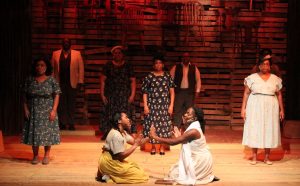 On stage at Lab Theater through October 2 is The Color Purple. Nearly four decades after the movie’s 1985 Los Angeles premiere, The Color Purple connects with African American women in much the same way that Sex in the City resonated with single white 30-something female urbanites. Why? Both gave their female audiences permission to be who they are
On stage at Lab Theater through October 2 is The Color Purple. Nearly four decades after the movie’s 1985 Los Angeles premiere, The Color Purple connects with African American women in much the same way that Sex in the City resonated with single white 30-something female urbanites. Why? Both gave their female audiences permission to be who they are 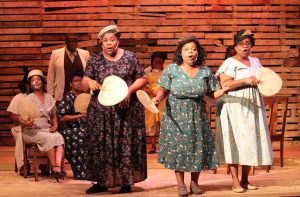 rather than the codification of what society expects them to be.
rather than the codification of what society expects them to be.
“Black women identify with the characters,” agrees Director Sonya McCarter wholeheartedly. “’Oh I see myself as Celie.’ ‘My grandmother was that person.’ ‘My aunt is that person.’ ‘Oh, I’ve experienced that.’ There’s a visceral connection to this story and 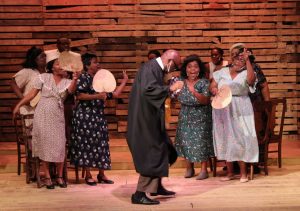 these characters that is so precious; so much so in our community that we quote the film. It’s that ingrained.”
these characters that is so precious; so much so in our community that we quote the film. It’s that ingrained.”
McCarter bemusedly references actor, director, producer and screenwriter Tyler Perry as someone who regularly quotes from the film. But he’s far from alone. Beyonce’ included a line from The Color Purple in her very first solo album. And, of course, 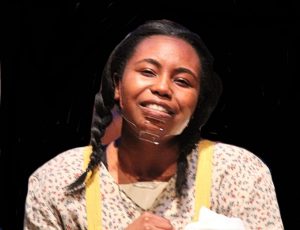 there’s Oprah (who produced the 2005 Broadway show) and Whoopi (who starred in the film). But then again, there’s so much wisdom and sage advice woven into Alice Walker’s rich and realistic dialogue, it’s hard not to find dozens of Maya Angelou-like aphorisms in the book, movie and stage show.
there’s Oprah (who produced the 2005 Broadway show) and Whoopi (who starred in the film). But then again, there’s so much wisdom and sage advice woven into Alice Walker’s rich and realistic dialogue, it’s hard not to find dozens of Maya Angelou-like aphorisms in the book, movie and stage show.
“The story is such a human story,” McCarter amplifies. “It’s about the human experience.”
 But the film was also about changing the perception of possibility for African-American girls.
But the film was also about changing the perception of possibility for African-American girls.
“[Prior to] the film’s debut, you saw black characters in stereotypical roles – drug dealers, thugs, the maid – or in sitcom serials,” McCarter observes. More often than not, they were caricatures that white writers projected on the African-American community.
The 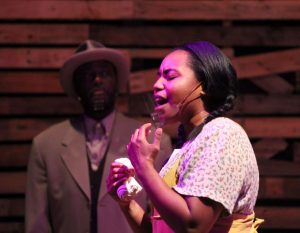 Color Purple represented a sea change in how black audiences saw themselves represented in media and entertainment.
Color Purple represented a sea change in how black audiences saw themselves represented in media and entertainment.
Whoopi Goldberg tells the story that when she was nine, Star Trek came on the family’s TV. After taking one look at communications officer Nyota Uhura (played by Nichelle Nichols), she ran through the house screaming for her mum and everyone else to come quick. 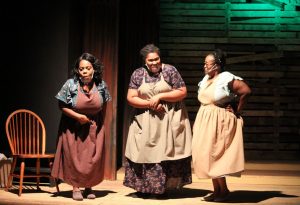 “There’s a black lady on television and she ain’t no maid!,” Whoopi uttered excitedly, pointing at the screen. “I knew right then and there I could be anything I wanted to be.”
“There’s a black lady on television and she ain’t no maid!,” Whoopi uttered excitedly, pointing at the screen. “I knew right then and there I could be anything I wanted to be.”
For black audiences, particularly female viewers, The Color Purple was and still is Star Trek on steroids. Not only is the entire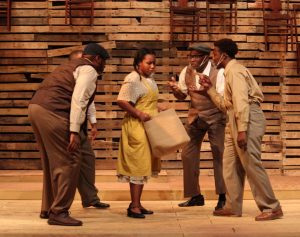 cast African-American, but the characters they play are eminently relatable.
cast African-American, but the characters they play are eminently relatable.
“I see my family, my family’s hardships, my ancestors’ hardships,” McCarter effuses. “I see their triumph. I see their resilience. I see Celie standing up for herself and finding her own voice. All of those things are just so beautiful.”
“We know her 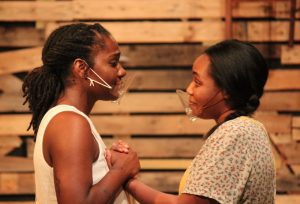 because she is us twice over,” wrote Victoria Bond for The New Republic in March of 2015. “For a black female audience, Celie feels like an ancestor who survived, so we might thrive. That a film about black women like The Color Purple was made at all feels like progress. Anyone who watches it has an opportunity—because of [Whoopi] Goldberg’s moving, Oscar-nominated performance—to walk in Celie’s
because she is us twice over,” wrote Victoria Bond for The New Republic in March of 2015. “For a black female audience, Celie feels like an ancestor who survived, so we might thrive. That a film about black women like The Color Purple was made at all feels like progress. Anyone who watches it has an opportunity—because of [Whoopi] Goldberg’s moving, Oscar-nominated performance—to walk in Celie’s 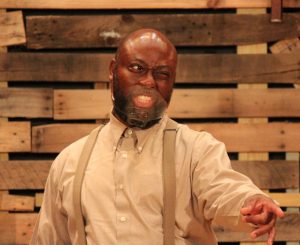 shoes and to experience how it feels to be black, poor, and ugly.”
shoes and to experience how it feels to be black, poor, and ugly.”
The Color Purple dispelled the myth that black women must be strong, stoic, long-suffering victims of not only physical, sexual and emotional abuse, but the whole misogynistic, patriarchal culture that makes their subjugation possible in the first place. The latter is by no means a racial or demographic societal structure, as evidenced currently by 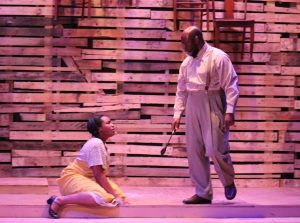 the male-dominated legislators and courts that are rushing to limit the rights that women have to control their own health care and require them to give birth to children thrust upon them in cases that even include incest and rape.
the male-dominated legislators and courts that are rushing to limit the rights that women have to control their own health care and require them to give birth to children thrust upon them in cases that even include incest and rape.
“You see in this story the sexism that was prevalent,” McCarter observes. “’I’m the male and you do what I say.’ But then you also see in Sophia, ‘I don’t care who you are; you’re 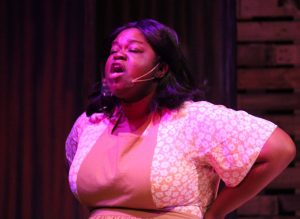 not going to oppress me, you’re not going to abuse me. I am woman.’”
not going to oppress me, you’re not going to abuse me. I am woman.’”
Just as Sex in the City gave single women permission to explore their sexuality and indulge their sexual urges, The Color Purple empowers black women to place themselves first instead of last, demand respect not only from the men in their lives but white 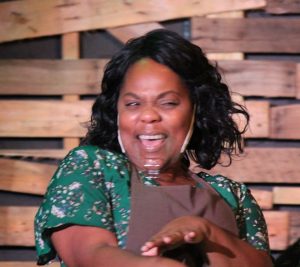 society, and acknowledge and express vulnerability, self-acceptance and, yes, even self-love. And like Sex in the City, Purple sounds the clarion call that women can derive limitless strength from and by supporting each other.
society, and acknowledge and express vulnerability, self-acceptance and, yes, even self-love. And like Sex in the City, Purple sounds the clarion call that women can derive limitless strength from and by supporting each other.
Ruthgena Faraco plays Celie. She was brilliant in the role of Mary Warren in Arthur Miller’s The Crucible, but her performance as Celie is nothing short of groundbreaking. She understands in an intuitive, 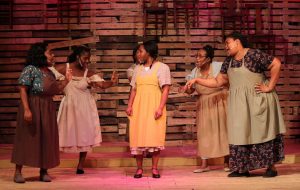 organic manner the many nuances of the universal themes underlying Alice Walker’s plot and characters. More, Faraco gives voice to this multilayered complexity in a simple, direct way that connects not just with the audience, but Ruthgena’s cast mates, who share a cohesion and chemistry that reverberates through every seat in the theater.
organic manner the many nuances of the universal themes underlying Alice Walker’s plot and characters. More, Faraco gives voice to this multilayered complexity in a simple, direct way that connects not just with the audience, but Ruthgena’s cast mates, who share a cohesion and chemistry that reverberates through every seat in the theater. 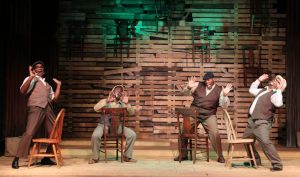 Add powerful, resonating vocals to superb acting and a subtly commanding stage presence, and a star is born! Yes, Ruthgena Faraco is really that good.
Add powerful, resonating vocals to superb acting and a subtly commanding stage presence, and a star is born! Yes, Ruthgena Faraco is really that good.
Cantrella Canady plays Sophia. As expected, she is stupendous in the role. What you’ll especially appreciate, though, in her portrayal 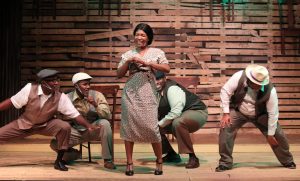 of Sophia is her uncanny ability to be both tough and vulnerable, brash then humbled, street smart yet politically naive. In the latter respect, she’s clearly mindful that her character is a metaphor of what can and does happen to assertive black women (and men) when they stubbornly refuse to live down to
of Sophia is her uncanny ability to be both tough and vulnerable, brash then humbled, street smart yet politically naive. In the latter respect, she’s clearly mindful that her character is a metaphor of what can and does happen to assertive black women (and men) when they stubbornly refuse to live down to 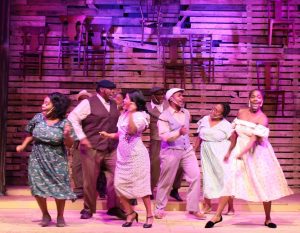 the expectations placed upon them by society and the white political power structure that it reflects. Canady’s performance in The Color Purple is yet another example of why I’d crawl a thousand miles on broken glass to see Cantrella Canady on stage.
the expectations placed upon them by society and the white political power structure that it reflects. Canady’s performance in The Color Purple is yet another example of why I’d crawl a thousand miles on broken glass to see Cantrella Canady on stage.
Robert Barner makes his theatrical debut as Mister. It’s a tough part, even for a veteran actor. Mister isn’t just physically 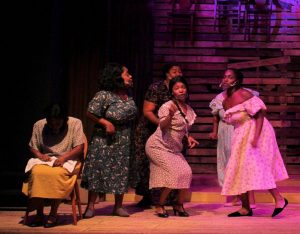 and emotionally abusive. He is to Celie what plantation owners were to their slaves prior to their emancipation, whip and all. He dehumanizes her by characterizing her as ugly, worthy only of cooking, cleaning and looking after his children (by multiple women) while he philanders, primarily with a lounge singer by the name of Shug Avery. Barner is terrific in the part, embracing his character’s malevolence.
and emotionally abusive. He is to Celie what plantation owners were to their slaves prior to their emancipation, whip and all. He dehumanizes her by characterizing her as ugly, worthy only of cooking, cleaning and looking after his children (by multiple women) while he philanders, primarily with a lounge singer by the name of Shug Avery. Barner is terrific in the part, embracing his character’s malevolence.  The role won’t be his last at Lab. In fact, Robert is scheduled to appear in at least two more Laboratory Theater productions during the 2021-2022 season.
The role won’t be his last at Lab. In fact, Robert is scheduled to appear in at least two more Laboratory Theater productions during the 2021-2022 season.
There are many stand-outs in this cast, and Kim Hardin is a joy to watch in the role of Shug. Her interactions with Celie anchor the 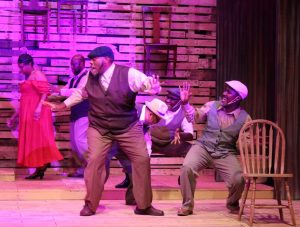 plot and storyline. Her soulful duets with Ruthgena Faraco linger long after their final notes.
plot and storyline. Her soulful duets with Ruthgena Faraco linger long after their final notes.
Another of the strong voices in this rendition of Purple is Julissa Jean-Bart, who plays Celie’s sister, Nettie. She’s one to watch going forward. Her forte is musical theater, with a background in dance and repertory, and that’s in full display in what’s primarily a 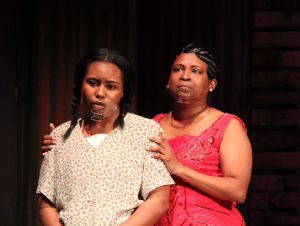 supporting role.
supporting role.
Boiled down to its essence, of course, The Color Purple is an affirmation and celebration of the black experience, and nowhere is that experience better understood than in its music which, in this case, is a luscious medley of jazz, gospel and soul.
“It is uplifting,” touts McCarter, who gives credit for the quality of the musical numbers to Musical Director Earl Sparrow. 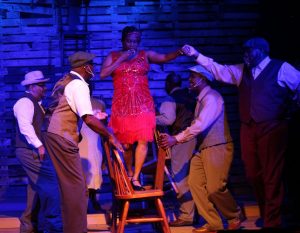 “The opening is Sunday morning, so we take you to church. Then later, you’re in the gyp joint having a wonderful time just singing and dancing, and it is kind of the same experience as you have in church, but at a different level. It shows that duality that we still have today. Back in the day, you had people who’d religiously go to church but then just as religiously go to that gyp joint and have some fun. So the music is uplifting.
“The opening is Sunday morning, so we take you to church. Then later, you’re in the gyp joint having a wonderful time just singing and dancing, and it is kind of the same experience as you have in church, but at a different level. It shows that duality that we still have today. Back in the day, you had people who’d religiously go to church but then just as religiously go to that gyp joint and have some fun. So the music is uplifting.  It’s inspirational. It’s beautiful.”
It’s inspirational. It’s beautiful.”
It is also why this show connects on an emotional plane with the audiences who see it.
The cast of The Color Purple also includes David Anderson, Faye Barrett, Monicke Clark, Tijuanna Clemons, Hoyt Goodine, Jade Sashay Green, 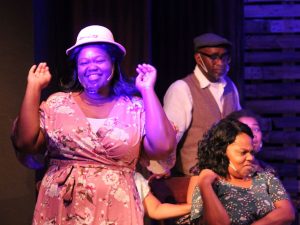 Edward Kelly and Cadrick Smith. They’re integral parts of the sights and sounds of this production, which was choreographed by the incomparable Bianca Russell. For several, The Color Purple represents their theatrical debut. You’d never know. They’re that polished. Kudos to Sonya McCarter for inspired direction, which included one part coaching, two parts education and a dash of stagecraft
Edward Kelly and Cadrick Smith. They’re integral parts of the sights and sounds of this production, which was choreographed by the incomparable Bianca Russell. For several, The Color Purple represents their theatrical debut. You’d never know. They’re that polished. Kudos to Sonya McCarter for inspired direction, which included one part coaching, two parts education and a dash of stagecraft 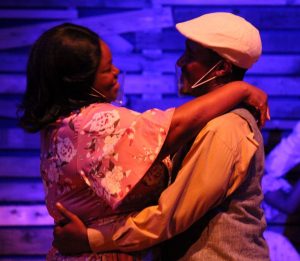 magic mixed in.
magic mixed in.
This is one show that deserves sold-out performances during the entirety of its run. So if you have any inclination to catch this musical before it closes on October 2, reserve your seat now.
The Color Purple is making its Southwest Florida premiere at the Laboratory Theater of Florida now through October 2.
September 7, 2021.














 Tom Hall is both an amateur artist and aspiring novelist who writes art quest thrillers. He is in the final stages of completing his debut novel titled "Art Detective," a story that fictionalizes the discovery of the fabled billion-dollar Impressionist collection of Parisian art dealer Josse Bernheim-Jeune, thought by many to have perished during World War II when the collection's hiding place, Castle de Rastignac in southern France, was destroyed by the Wehrmacht in reprisal for attacks made by members of the Resistance operating in the area. A former tax attorney, Tom holds a bachelor's degree as well as both a juris doctorate and masters of laws in taxation from the University of Florida. Tom lives in Estero, Florida with his fiancee, Connie, and their four cats.
Tom Hall is both an amateur artist and aspiring novelist who writes art quest thrillers. He is in the final stages of completing his debut novel titled "Art Detective," a story that fictionalizes the discovery of the fabled billion-dollar Impressionist collection of Parisian art dealer Josse Bernheim-Jeune, thought by many to have perished during World War II when the collection's hiding place, Castle de Rastignac in southern France, was destroyed by the Wehrmacht in reprisal for attacks made by members of the Resistance operating in the area. A former tax attorney, Tom holds a bachelor's degree as well as both a juris doctorate and masters of laws in taxation from the University of Florida. Tom lives in Estero, Florida with his fiancee, Connie, and their four cats.